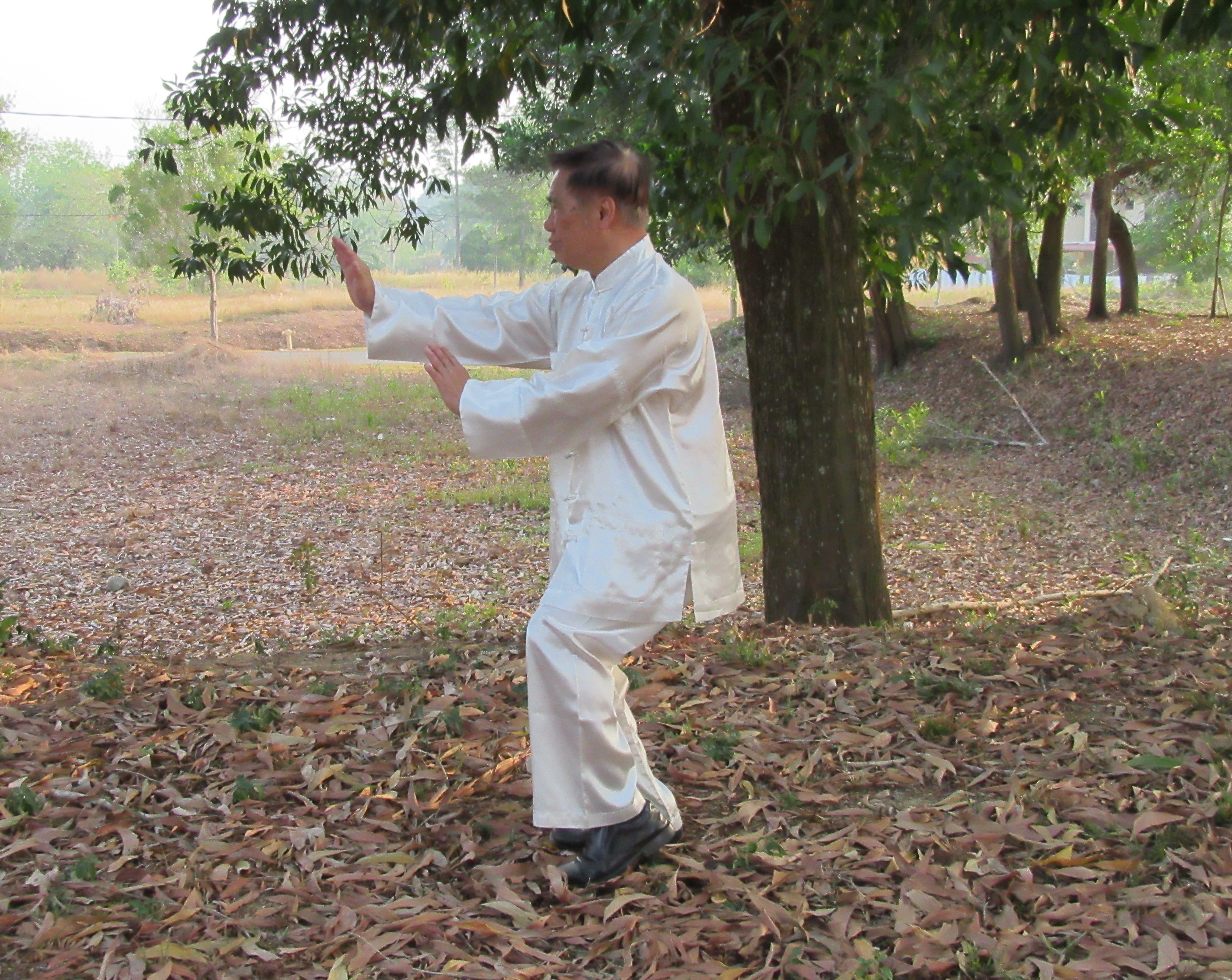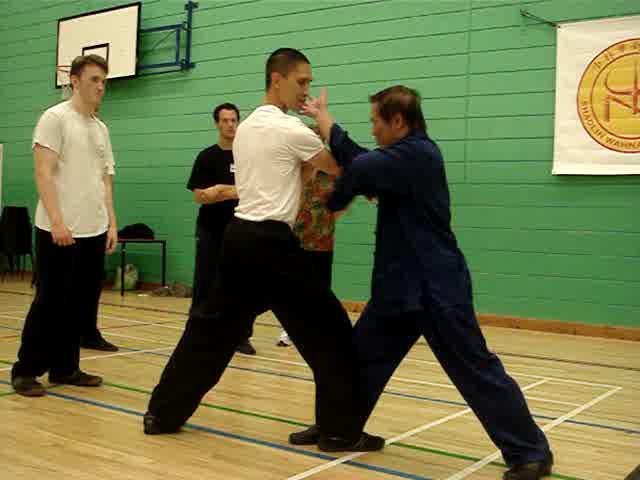SELECTION OF QUESTIONS AND ANSWERS
DECEMBER 2017 PART 1

Golden Axe Strikes Rock
Question 1
What is the difference between silliness and nonsense?
— Sifu Barry Smale, Shaolin Wahnam UK
Answer
The difference is self-explanatory, like asking what is the difference between A and B, though A and B may have common features.
A is A, and B is B. Silliness is silliness, and nonsense is nonsense, just as an apple is an apple, and an orange is an orange.
To attempt a dictionary definition, which actually makes the question more difficult if one already knows the meaning of the two words, silliness is anything that denotes foolishness, and nonsense is anything that does not make sense.
Common features that apply to silliness and nonsense are that both lack mental clarity, and are modes of behavior that people dislike to have on themselves though it may be fun on others.
Hence, to be silly is not the same as to be nonsensical. A person may be silly and not nonsensical, or he may be nonsensical and not silly, or he may be both.
Being silly or nonsensical is different from pretending to be silly or nonsensical. Two main reasons why people pretend to be silly or nonsensical are to have fun, and to deceive others.
Question 2
In the Three-Circle Stance just now you told us just to drop our hands and go to standing mediation at the completion of the stance. In some books, it is advised that practitioners bring chi from the Cosmos into their dan tian. Which method is better?
— Sifu Christina Didyk, Shaolin Wahnam USA
Answer
Just dropping the hands is better. It enables chi to be focused at your dan tian and build your internal force.
If you raise your hands to bring chi from the Cosmos, you cause chi to rise to your arms.

Three-Circle Stance
Question 3
I have some shoulder pain. Can I overcome the pain by practicing Three-Circle Stance?
— Penny, USA
Answer
Yes, in our school you can overcome your shoulder pain by just practicing the Three-Circle Stance or any stance, followed by chi flow. This is because we have triple cultivation in our school no matter what you practice. In other words, by practicing Three-Circle Stance followed by chi flow, not only you practice the physical form of the stance, but you also practice chi kung and spiritual cultivation at the same time. The chi flow following your Three-Circel Stance or any stance will overcome your shoulder pain.
In most other school, if a student has shoulder pain, he (or she) cannot overcome his shoulder pain by practicing Three-Circle Stance. He has no chi flow. This is because most other schools practice the stance only at a physical level, and not as triple cultivation which includes the physical, energy and mind levels.
Nevertheless, even when by practicing the Three-Circle Stance can overcome your shoulder pain, or any health problem, it is not the best choice. If you practice exercises from what you learned yesterday (Penny attended the chi kung class the previous day called "Generating Energy Flow for Health"), like "Dancing Butterfly" and "Bear Walk", you can overcome your shoulder pain more effectively.
As a rough guide, if you practice Three-Circle Stance followed by chi flow, you may need 3 weeks to overcome your shoulder pain. If you practice "Dancing Butterfly" or "Bear Walk", you may need only 1 week. If you practice Three-Circle Stance wrongly or you over-train, you aggravate your shoulder pain. If you practice "Dancing Butterfly" or "Bear Walk" wrongly, or you over-train, you may not aggravate your shoulder pain. Moreover it is less likely that you practice "Dancing Butterfly" or "Bear Walk" wrongly or over-train.
The chi kung, which generates energy flow that overcomes your shoulder pain, is more powerful in Three-Circle Stance than in "Dancing Butterfly" or "Bear Walk". Then why is it more effective to overcome your shoulder pain or any illness using a less powerful chi kung exercise? It is a mis-conception by many people that the chi kung that overcomes illness, like cancer for example, must be very powerful. This is not true. In fact chi kung that overcomes illness or pain, called medical chi kung, like "Dancing Butterfly" and "Bear Walk", is the least powerful. Chi kung to develop internal force and mental clarity, called peak performance chi kung, like Three-Circle Stance, is more powerful.
Here, Dancing Butterfly or Big Windmill is more effective than a kungfu set like Four Gates because we choose the right type of chi kung for our purpose. Dancing Butterfly and Big Windmill belong to medical chi kung and chi kung for health. Four Gates belongs to kungfu or chi kung for peak performance. Medical chi kung or chi kung for health is less powerful than kungfu or chi kung for peak performance.
Indeed, one should be healthy first before practicing chi kung for peak performance. If he is sick or in pain, he should practice medical chi kung to overcome his problem, and leave peak performance chi kung until he is healthy. If he has no access to medical chi kung, he may use peak performance chi kung to overcome pain or illness, but he must avoid over-training.
Question 4
Various sets in our curriculum have uses of both single palm strikes (e.g. Single Dragon Emerges From Sea, Fierce Dragon Across Stream, and Golden Axe Strikes Mountain) as well as double handed techniques (e.g. Wild Horses Charge Stable and Double Butterfly Palms).
Could Sifu elaborate on when it is most beneficial to use one palm versus both simultaneously? For example, is it more favorable to use a double handed strike only to finish off a vulnerable opponent or for using release force to push them away, versus the seemingly more conservative single handed techniques being uses to test, feint, and deal with an opponent of higher skill and better position?
— Dr Fredrick Chu, USA
Answer
At the most basic level, the single palm strike, like Single Dragon Emerges from Sea, is used when you wish to strike an opponent with one palm, and the double palm strike, like Wild Horses Charge Stable, is used when you wish to strike him with both palms.
However, just a strike with one palm is sufficient to injure an opponent; there is no need to use two palms. Moreover, the other non-striking hand can be used for defence if the opponent counter-attacks. So, when are two palms used in a double palm strike?
There are two main reasons. One is for practicing. Both palms are used in practice, which is more balanced than using one palm, but in application only one palm is used in striking.
The second reason is to cover an opponent's hand when striking with two palms, as in Double Butterflies Flying. In other words, one palm is used to cover the opponents hands, and the other palm is used in striking.
As you have keenly perceived, when you are sure that an opponent cannot strike you, i.e. you need not cover him, using two palms is more effective to finish off an opponent or to push him away with release force than using one palm.
On the other hand, if you wish to test an opponent, to use a feint move, to trick him to attack, or to maneuver him into an unfavorable position, using one palm is preferred to using two palms.

Cosmos Palm
Question 5
How can someone trained in Cosmos Palm use it to help someone else overcome injuries both internal and external, for example relieving the injury of a Cosmos Palm, Marvelous Fist, or Dim Mak strike, or a Chin Na grip?
— David, USA
Answer
A Cosmos Palm practitioner can help an injured person overcome his injury in two main ways:
- He uses his internal force to clear energy blockage caused by the injury.
- He uses his internal force to help the injured person to generate an energy flow, which will clear the injury.
Question 6
How would we use Cosmos Palm to help someone else overcome stomach pains and other minor illness and injury?
Answer
This is relatively simple, but it still needs some skills.
Let the ill or injured person lie comfortably. Place a palm about 6 inches to a foot above the stomach, illness or injured part. Gently rotate the palm from the centre of the stomach, illness or injured part to its periphery for about 5 minutes, simultaneously thinking that the internal force from the Cosmos Palm will clear the energy blockage of the patient.
Flick the palm, like flicking away water, after the treatment to prevent bad energy from the patient locked in the palm. If necessary, perform "Lifting the Sky" or other suitable chi kung exercise to replenish the energy used in the healing.

The famous Butterfly Palm
Question 7
Are God and the Void different?
— Jussi, Finland
Answer
The answer is yes and no. This means the answer can be "Yes, God and the Void are different", or "No, God and the Void are not different; they are the same."
A main factor determining whether the answer is yes or no, is connotation.
"God" has a personal connotation, whereas "Void" is non-personal. In this context, the answer is "Yes, God and the Void are different."
In a non-personal way, "God" refers to the infinite and eternal, and "Vodi" also refers to the infinite and eternal. Hence, the answer is "No, God and the Void are the same."
In the trinity concept, God can be interpreted as God the Holy Spirit, God the Father, and God the Son. It is similar to the Buddhist concept of the Triple Body of the Buddha, which is the Spiritual Body, the Reward Body and the Transformational Body.
God the Holy Spirit, or the Spiritual Body of the Biuddha, is the same as the Great Void. God the Father and God the Son, or the Reward Body and the Transformational Body of the Buddha, are different from the Great Void.
Question 8
Is paradise different from release from samsara?
— Vero, Uruguay
Answer
Again, the answer can be yes and no, depending on how different people interpret the terms "paradise" and "samsara".
If people interpret "paradise" as where there is no suffering, and "samsara" as the world of suffering, then paradise is the same as release from samsara.
If people interpret "paradise" as where there is no suffering, and "samsara" as the phenomenal realm, the answer is "No, paradise is different from release from samsara, because paradise is still in the phenomenal realm."
Instead of intellectualizing whether paradise is the same as release from samsara, or whether God is the same as Void, it is better to live a happy and healthy life here and now. In the same way, don't waste your time intellectualizing on what is "happiness" and what is "sadness", or on what is "sickness" and what is "health", but be happy and healthy.
If you have any questions, please e-mail them to Grandmaster Wong via his Secretary at stating your name, country and e-mail address.
LINKS
Selected Reading
- The Chameleon
- Tapping into Cosmic Love and Wisdom
- Change from Worrying about How to Defend against your Opponent's Attack to Letting him Worry about How to Defend against your Attack
- Northern Shaolin Seven-Star Set
- Dublin is Good for You
